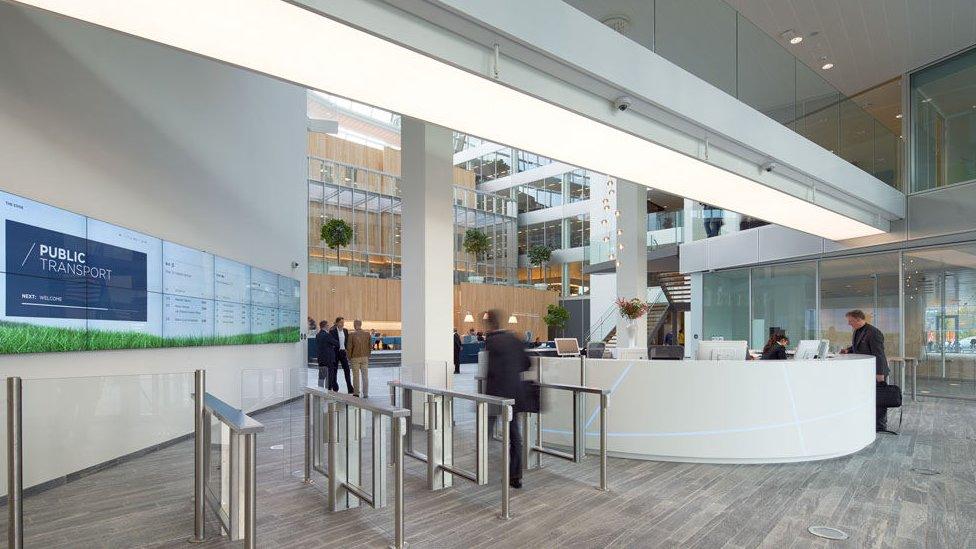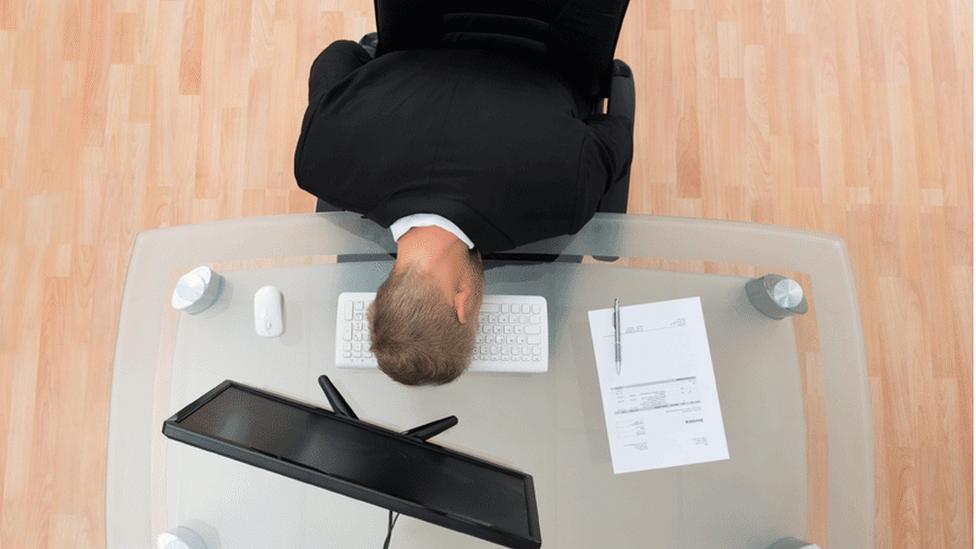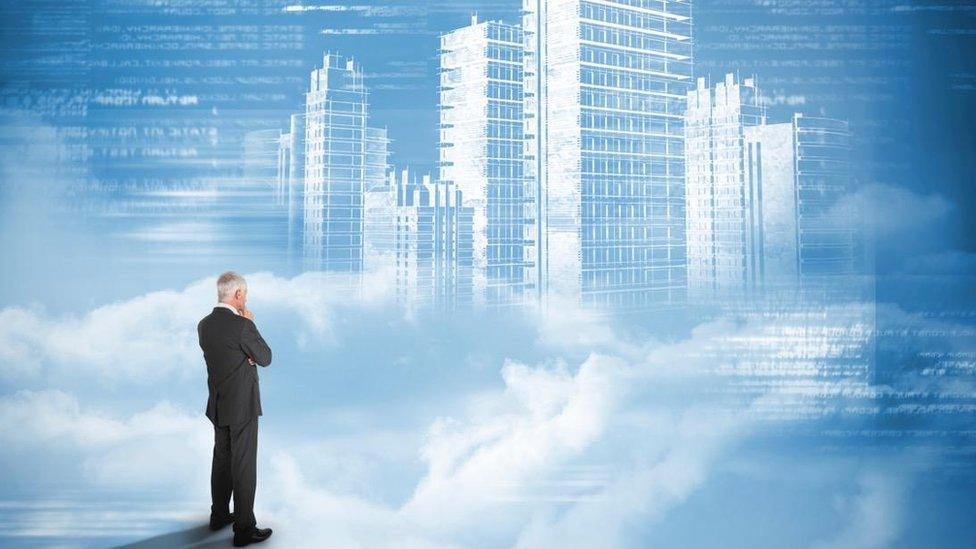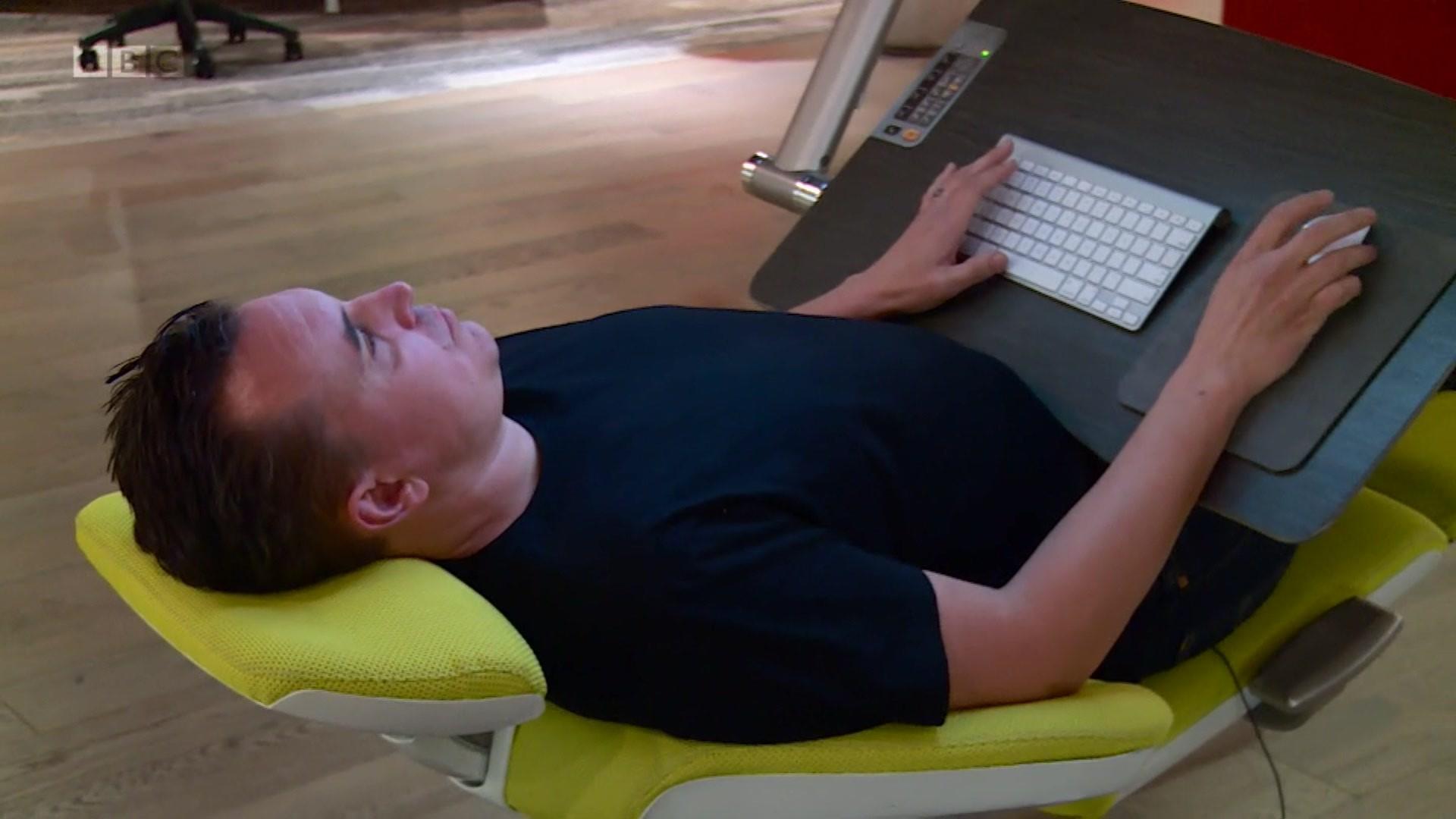Will tomorrow's smart office be a saviour or a spy?
- Published
Six things in the offices of the future
Over the next six weeks the BBC will examine how our built environment is changing. Tomorrow's Buildings will look at how technology is making our offices smarter, our homes more affordable and even transforming building sites.
Ask someone what they dislike about working in an office and the list will probably be long.
It is likely to include: workload, the boss, colleagues, uncomfortable chairs, lack of light, no decent food in the canteen and Arctic air-conditioning.
Technology may soon be able to ease the last of these, offering a better working environment by allowing workers to control their heating via a smartphone app.
But does that come at a price? Do the sensors that are increasingly making the office environment smarter also mean that workers are under constant surveillance?
Welcome to the brave new world of the smart office.

Workers at Deloitte's headquarters in Amsterdam have smart desks
Research firm Gartner predicts that commercial buildings will have more than 500 million "connected things" during 2016.
The biggest driver for this is to improve energy efficiency - currently commercial buildings account for 40% of the world's electricity consumption.
By embedding hundreds of sensors in walls, ceilings or even lights, the systems that keep the office running smoothly can be connected and in turn these building management systems (BMS) can be connected to the corporate network and the internet.
At Deloitte's headquarters in Amsterdam, workers can control the lights, heating and blinds via an app, while in London building consultant Arup is experimenting with smart desks - embedding sensors in them and hooking them up to smartphone apps to allow people to control lighting and heating.

Would giving people more control over the building's heating and lighting make them feel happier?
Smarter systems offer huge potential energy savings - estimates range between 20% and 50%.
"A staggering amount of energy is wasted on heating empty offices, homes and partially occupied buildings," said Carlo Ratti, who heads up the Massachusetts Institute of Technology's Senseable Cities lab.
His team is working on a project that measures the number of people in a building and adjusts heating and lighting accordingly - with a view to turning an empty building "off", just like a computer goes into standby mode when not in use.
He is also working on localised heating and cooling systems, which can provide a precise, personal climate for each occupant using "an array of responsive infrared heating elements that are guided by sophisticated motion tracking".
"Individual thermal 'clouds' follow people through space, ensuring ubiquitous comfort while improving overall energy efficiency," he explained.

Much of the smart technology in use is about making buildings greener
That will appeal to anyone who has complained about the air conditioning and comes amid mounting evidence that people do require different temperatures - women, for instance, feel comfortable in heat that is several degrees higher than the ambient temperature preferred by men, according to a study from Dutch scientists last year., external
Smarter lighting or heating is all well and good when it works but, like most technology, it isn't always fit for purpose.
Doug King, a member of the Royal Academy of Engineering and expert on smart buildings, told the BBC: "There are lots of apocryphal stories about lighting systems being over-ridden by cleaners who don't want to clean in the dark or tales that, if one person is working late, the lights remain on in large parts of the buildings.
Sinister tech?
"People will do what they have to do to get their jobs done in the level of comfort they need and that may mean hacking the building. They may shut off the systems by sticking Sellotape over the sensors or the building maintenance staff may reset the controls because they simply become fed up with all the complaints."
A case, perhaps, of smart building versus smart human.

Smart lighting should in theory make fully lit buildings after dark a thing of the past
Concerns about the smart lighting not working could pale into insignificance next to the wider question about what data all the hidden sensors around a building are collecting.
Architect Rem Koolhaas has spoken out against the way technology is infiltrating buildings, saying it is "totally astonishing" that people are willing to sacrifice their privacy for convenience and describing the rise of smart systems as "potentially sinister".
He told Dezeen magazine, external that the use of smart technologies represented the most radical shift in architectural practice for over a century - architects had become too distracted by the benefits and overlooked the dangers.

Do workers want sensors that know where they are in the office?
Most building data is currently collected anonymously but that doesn't mean it could not be used for other purposes.
"You could imagine using data from a building management system to find out when someone is in the office and when they are not," said Mr King.
British newspaper the Daily Telegraph did just that earlier this year, fitting under-desk sensors to measure occupancy with a view to using the data to make the office more energy-efficient.
Staff did not see it quite that way, reacting with anger - while the National Union of Journalists described it as "surveillance" and the trial was hastily withdrawn, just a day after it had been announced.
It illustrates the fact that smart buildings may mean very different things to different people.
On the one hand is the landlord, who wants to make savings on energy and other costs, and on the other are the people who live and work in those buildings and may not appreciate being monitored during their working day - even if it is done anonymously.

Will we need to work in offices in the future?
We need to make sure technology is serving the people who work in such buildings, thinks Arup's director of architecture Nille Juul-Sorensen.
"We have to start with the humans, putting people first and then the technology that can help them," he said.
And Mr King said there were ways of using data to help usher in a new era of smarter design.
"Ten years ago we were just guessing but now there is an awful lot more data about ways people are using buildings which can be fed back to improve the next ones," he said.

The buildings of the future will have their own operating systems, but who will control them?
Increasingly, firms such as Deloitte and Arup are using technologies such as virtual reality to give potential clients an idea about how a building will look before they move in.
Ultimately, thinks Mr Juul-Sorensen, designers need to start asking even more radical questions about how we will work in future - is it, for instance, smart to even have an office at all in an era when the internet can connect people in different parts of the world?
"The way we work is very different from 20 years ago and yet we are still basing our design on the old days and then building in a lot of technology. We are designing for the past not the future," he said.
Read more at bbc.co.uk/tomorrowsbuildings
- Published16 December 2015

- Published20 October 2015
